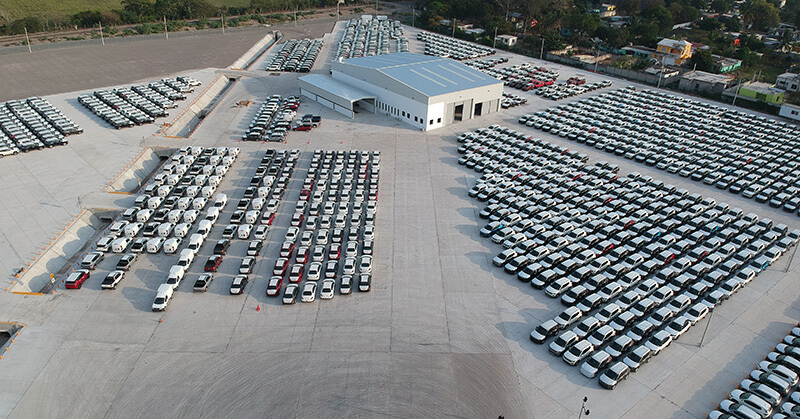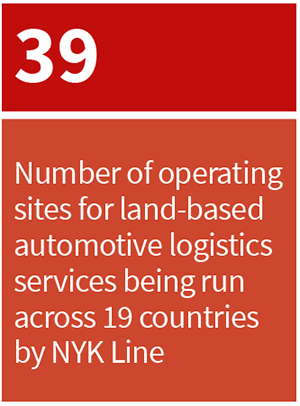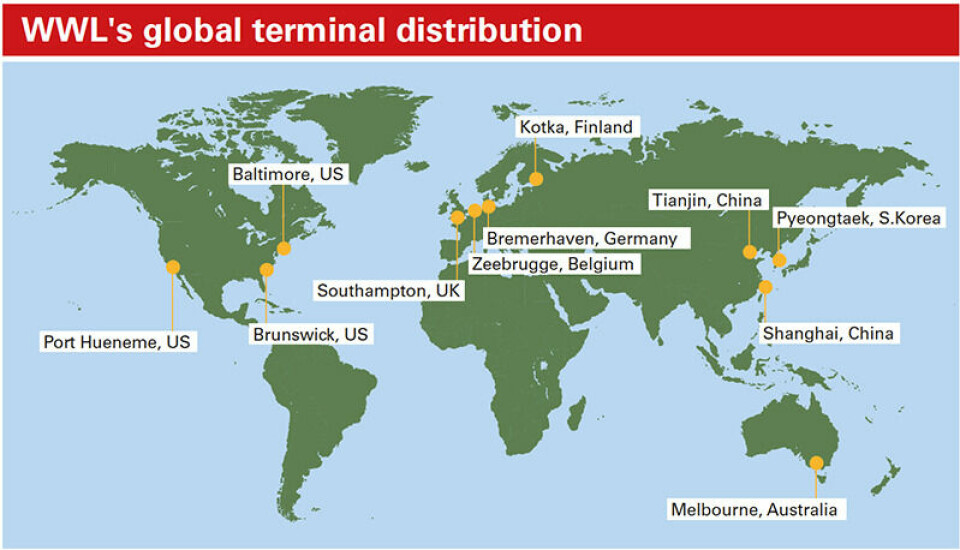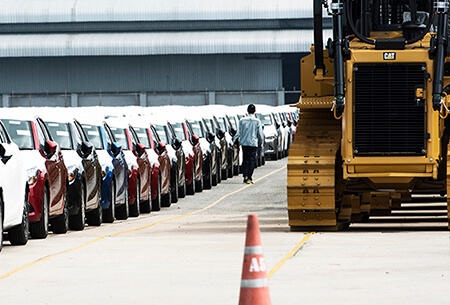Moving on to terra firma
 Following sustained pressure on margins in recent years, the global shipping industry has witnessed some radical changes, with consolidation and technology combining to reconfigure the way many shipping lines approach new business.
Following sustained pressure on margins in recent years, the global shipping industry has witnessed some radical changes, with consolidation and technology combining to reconfigure the way many shipping lines approach new business.
With competition on the waves mounting, one new channel for many car carriers has been to expand into land-based operations, including investing in terminals, portside vehicle handling and more, as they seek to extend their influence further along the supply chain.
“For every vehicle in the world, from when it leaves the production line until [it is] recycled at end of life, there remains a logistics and servicing need. We see it as our purpose to work with our customers in defining and developing logistics for this world in motion [and] develop our logistics infrastructure and service capability on sea and on land,” comments Craig Jasienski, CEO of Wallenius Wilhelmsen group.
Formed last year from the merger of Sweden’s Wallenius and Wilhelmsen of Norway, ro-ro specialist Wallenius Wilhelmsen is one of a number of shipping lines spearheading the push into land-based activities, and it recently launched a new division focused on this. Formed in March this year, Wallenius Wilhelmsen Solutions (WW Solutions) sets out to embrace the ‘significant changes’ taking place in the automotive and rolling equipment industries, and act as a key part of a reconfigured supply chain.
“As a whole, Wallenius Wilhelmsen is on a growth trajectory and right now, we see the land-based arena as the most interesting area to build scale, both organically and through acquisition… as the WW Solutions land-based unit approaches $1 billion in turnover, we see many more opportunities,” says Raymond Fitzgerald, chief operating officer at WW Solutions.
“Wallenius Wilhelmsen is on a growth trajectory and right now, we see the land-based arena as the most interesting area to build scale, both organically and through acquisition.” - Craig Jasienski, Wallenius Wilhelmsen
WW Solutions currently operates 11 terminals globally in five different land-based business verticals: terminals and stevedoring; vehicle processing; heavy equipment technical services; inland distribution; and supply chain management.

“We evaluate each opportunity on its own merits and future possibilities. Of course, within WW Solutions we have an overarching strategy that connects all of the businesses from a strategic perspective, but operationally, we take a portfolio management approach where each profit centre is managed and evaluated on a standalone basis,” explains Fitzgerald.
The WW Solutions portfolio currently includes terminals in Port Hueneme, Baltimore and Brunswick in the US; Southampton, Zeebrugge and Bremerhaven in Europe; and Pyeongtaek, Tianjin, Shanghai and Melbourne on the Pacific Rim.
Japanese shipping group Nippon Yusen Kabushiki Kaisha (NYK Line) is another leading operator that has expanded into land-based automotive handling in recent years as it aims to develop its automotive footprint globally.
“We have 39 operating sites for land-based auto logistics services in 19 countries, including terminal businesses, inland transport and value-added services, such as pre-delivery inspection, for example,” says Yutaka Ikeda, general manager of auto logistics at NYK Group. “We believe that we are getting to be known as an auto logistics service provider, not just a shipping company, as we are getting opportunities to participate in several logistics services for customers.”
The desire to become more deeply embedded in customers’ supply chains and gain recognition as an integrated logistics provider, as opposed to just a shipping line, is also behind moves by Norwegian firm Höegh Autoliners to develop land-based operations linked to its deep-sea and short-sea networks.
“One of Höegh’s key drivers for expanding into the supply chain is to increasingly be able to help improve our customers’ supply chains. By working closely with our key customers, we can identify bottlenecks and see where efficiency improvements can be realised,” says Henrik Zander, head of logistics services at Höegh.
 An example of this has been Höegh’s inauguration of a new facility in Port Freeport, Texas, which has opened up “a new export opportunity” within the US Gulf, according to Zander, helping OEMs to shorten distribution lead times, reduce supply chain costs, and alleviate pressure on inland transport as well as reducing the environmental footprint.
An example of this has been Höegh’s inauguration of a new facility in Port Freeport, Texas, which has opened up “a new export opportunity” within the US Gulf, according to Zander, helping OEMs to shorten distribution lead times, reduce supply chain costs, and alleviate pressure on inland transport as well as reducing the environmental footprint.
The move to develop cross-industry links and partnerships is a common path for shipping lines seeking to expand into landside vehicle handling. Last year, Italian shipping company Grimaldi Group strengthened its operating partnership with state-run rail firm Mercitalia to ship Alfa Romeo cars, with the partners inaugurating a regular rail service from Cassino to Civitavecchia to connect with Grimaldi vessels bound for the US.
Grimaldi has also stated an intention to build out its own terminal portfolio, with a recent acquisition including the takeover of erstwhile shipping agent Marittima Spedizioni’s operations at the port of Savona in Italy, putting Grimaldi in direct control of Savona Auto Terminal.
Driving the trendWhile the exact reasons behind any expansion into land-based services can be different for each company, there are several general issues pushing this trend forward.
Perennial considerations such as costs and efficiency always play a part, but new concerns such as rapid consolidation across the shipping industry and major changes in global trade flows have also helped to reshape both the supply and the demand side of the equation for shippers.
In addition to the congestion seen at many import and export hubs, changes in production have also had a significant impact on trade flows. There has been a sharp drop in deep-sea exports from Japan, for example, but a sharp uptick in European luxury exports to China over the last decade.
“East-west vehicle trade continues to lose market share, accounting for 42% of global seaborne trade in CEU (car equivalent unit) terms, down from 52% a decade ago, at the expense of intra-regional trade as new production centres emerge in or closer to emerging markets,” notes Tom Ossieur of Drewry.
This, in turn, has resulted in a more disjointed environment for shippers when trying to slot into the supply chain, as existing land-based providers are often ill-equipped to meet demand in many locations.
“Land-based logistics is today a very fragmented industry, with many small and medium-sized players operating in each individual market. By using best practice sharing between markets and sites in which we operate, and by using local expertise built up in the ocean division, we can quickly have a professional set-up of landside logistics in new locations,” says Henrik Zander of Höegh.
“Besides fully owned initiatives on land, Höegh continuously seeks partnerships with local logistics companies. This way, we can combine our operational experience, customer knowledge and technology offering with their local expertise to jointly create an attractive offering in the market,” he states.
Such changes also feed into another factor driving the trend: congestion.
“There is some fear from car manufacturers that there are not enough new vessels being ordered and that this might complicate the landside operations, potentially leading to delays. An increase in transhipment would push volumes up at key ports, some of which are already operating at or beyond full capacity, such as in north-west Europe and Mexico,” says Tom Ossieur, associate consultant at Drewry.
Höegh cites its operations through Horizon Auto Logistics in Veracruz as an example: setting up an off-port facility outside Veracruz has eased congestion within the port, leading to operational improvements and driving wider integration.
“The company’s services in Mexico now include vessel cargo handling, port yard management, vehicle services inside the port, and shuttle between port and our off-port facilities, including full yard and vehicle processing capabilities at the off-port facility. This is all tied together by one IT system through seamless management for exports, imports and general distribution,” says Zander of Höegh.
Weighing up costs and benefitsNot all shipping lines view the drivers for growth from the perspective of their existing ocean-going business units, however. Some consider expansion on a cost-benefit basis.
“It’s simply the fact that we see some interesting business opportunities and the possibility to gain competitive advantage in several areas of the land-based logistics segment,” says Fitzgerald at WW Solutions. “The fact that some of the entities we manage and have invested in complement and support our group ocean businesses is a terrific ancillary benefit, but it hasn’t been the primary driver.”
A raised focus on ro-ro rates from competition authorities and the introduction of tariffs and taxation aimed at interrupting key trade routes have also pushed shippers in this direction by disrupting the bottom line for many, making them wary of being stranded or unable to react to supply chain needs.
As the threat of a full-blown trade war between China and the US develops, tackling these changes and preparing for further ones in future has led many shipping lines to explore ways to control more of the supply chain in a bid to achieve greater flexibility.
For car carriers, this has created a number of pain points. Without direct control or experience in managing landside activities, car-carrying shipping lines are often at a disadvantage when negotiating costs, for example.
[mpu_ad]“It’s really a combination… We are growing our network and product capabilities organically in line with our customers’ evolving needs; we are making outright acquisitions; we are making acquisitions in a JV format where we secure a majority of the equity but keep the leadership of the acquired company in place as a partner; we form situational partnerships for specific opportunities that, once achieved, are sunset [redundant]; and we recognise that technology and IT applications are an essentially important and growing component of a successful logistics management portfolio,” says WW Solutions’ Fitzgerald.
Emerging market attractionWhen considering where to invest, the outlook for each shipping line is quite different, with many building from a strong base in a particular geographic location or aiming to consolidate their foothold across existing trade routes.
However, the fragmented nature of many emerging markets and the relative ease with which shipping lines can gain traction in underdeveloped regions is also attractive to these companies.
“We will develop the auto logistics business in developing countries where higher growth of automotive industries is expected and also changing services in accordance with changes in the needs of the industry,” says Ikeda at NYK Group.
Likewise, fellow Japanese group K Line sees increased potential for landside activity in emerging markets due both to expanding sales and the current lack of developed multi-modal infrastructure.
“Automobile sales are expanding in emerging economies, primarily in South-East Asia and South America, and demand for services ancillary to the transport of finished vehicles is rising accordingly,” K Line states, adding that the firm “continues to broaden” its land-based vehicle logistics services.
(Click to enlarge)

Looking further aheadOver the longer term, it seems certain that shipping lines will continue to invest in land-based activities, but the exact nature of such investments remains hard to predict, dependent as it is on a rapidly changing global market.
“I think we will continue to see interesting developments by some in certain segments and geographies, while elsewhere, we will continue to see a contraction by others as they refocus energies and efforts on their core business,” Fitzgerald predicts.
Greater integration – across subsidiaries for larger operators and with partners for smaller players – seems certain to be a key focus as technology helps to bring disparate businesses together.
“By utilising our strengths and enhancing coordination, we will provide a higher level of logistics services [and] provide multimodal service to customers, not just ocean transport. Being one of the biggest car-carrier vessel operators in the world, we have the strength to achieve high-quality transport,” says NYK’s Ikeda.
Such aspirations do depend, however, on shipping lines finding the right skills and people to deliver their land-based services, stresses Fitzgerald.
“Without question, talent is the most important investment we are making right now, and matching the right person and skills with the roles that are emerging in the logistics world of today is probably the most challenging process we face,” Fitzgerald confirms.
“As we offer services across the whole outbound supply chain, it is becoming increasingly important to have people in the organisation with knowledge and understanding that stretch throughout the automotive supply chain,” Zander of Höegh concurs.
Ultimately, finding staff with a sufficiently holistic view of the business from end to end may require shipping lines to push even further onto dry land.
“One of Höegh’s key drivers for expanding into the supply chain is to increasingly be able to help improve our customers’ supply chains.” - Henrik Zander, Höegh
 While shipping lines have taken a variety of paths to build landside business, a common thread across successful developments has been the need for greater visibility through the supply chain and the development of new systems and technology to improve tagging and monitoring of cargo.
While shipping lines have taken a variety of paths to build landside business, a common thread across successful developments has been the need for greater visibility through the supply chain and the development of new systems and technology to improve tagging and monitoring of cargo.
“Supply chain visibility continues to improve all the time and technology is the enabler for that evolution,” says Raymond Fitzgerald of WW Solutions. “We’ve come a long way from the early days of track-and-trace, when intermittent status updates at certain milestones or transfer points were the norm. Since then, the industry has moved on to barcodes, RFID technology, telematics and, in some cases, satellite tracking,”
WW Solutions invested in a new subscription-based visibility tool earlier this year, which was rolled out on an Oracle platform using Java technology that harnesses a variety of data inputs to give customers a streamlined, real-time view of their units, he explains.
“The tool enables customers to make all sorts of decisions earlier in the process with far greater confidence. It’s a great tool and we see enormous possibilities to leverage it across our network of services,” says Fitzgerald.
Visibility is also key for Höegh’s fully-owned subsidiary Autotrans, which has taken the initiative in improving visibility for the finished vehicle industry by developing purpose-built tracking software that gives the customer access to advanced technology for tracking, follow-up and performance reporting.
“Autotrans recently launched a new app for vehicle reception and handover that guarantees real-time traceability of the vehicles and a secured transfer of responsibility,” states Henrik Zander. “Besides improving visibility, the app also enables automation and digitalisation of manual handling activities and paper-based processes.”
He continues: “There are obviously some differences between the IT systems required on land and at sea. Höegh uses a dedicated technology to run our land-based services; however, we see a lot of synergies and overlaps where technology improvements we do on land can also serve us on the ocean business, and vice versa.”
An end-to-end focus on IT is a major differentiator for shipping lines when it comes to land-based operations, and one that warrants significant investment as they seek to stay ahead of competitors – but the rapid change of technology from OEMs is also of interest for forward-looking businesses, it seems.
“We see shifts from car ownership to car usership, an increase in the scale of autonomy, increased electrification of vehicles and new entrants providing mobility solutions in very different ways – all challenging existing supply chain, retail and servicing models for vehicles,” says Craig Jasienski of Wallenius Wilhelmsen.
“In addition to the systems needed to operate the terminal and optimise inland transportation, and considering the trend towards CASE [connected, autonomous, shared and electric vehicles] in the automotive industry, we think it may require systems to manage and visualise transportation status at each individual vehicle base, with a higher level of accuracy and in a timely manner,” Ikeda of NYK adds, suggesting that more investment is forthcoming.
Fitzgerald of WW Solutions agrees, estimating that the combination of investments over the last 18 months and those WW Solutions envisions in the year to come is in the several-hundred-million dollar range.
“Right now, we are focused on digitalisation and the streamlining and harmonisation of existing applications and platforms, while at the same time, investing in new applications and technologies to position us for the future,” Fitzgerald states.
“We see shifts from car ownership to car usership, an increase in the scale of autonomy, increased electrification of vehicles and new entrants providing mobility solutions in very different ways – all challenging existing supply chain, retail and servicing models for vehicles.” - Craig Jasienski, Wallenius Wilhelmsen





